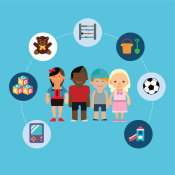Critical Information
The number of children ages 3 to 17 struggling with anxiety or depression rose by 1.5 million between 2016 and 2020. Educators trained in resilience will fortify their students and raise their potential for learning.
Two modes for promoting student resilience
Synchronous solutions…
include facilitated small group discussion, coaching, workshops, and more. Our unique web events include live group therapy, humor workshops to infuse fun into the classroom and even live events with comedians. Enjoy the video example.
Asynchronous solutions…
include on-demand video engagements on a range of topics from autism to dealing with difficult students. Faculty (and parents) can learn the rubric for developing greater resilience, will pass along this learning to students. Please enjoy this video montage on student engagement from our on-demand video library.
On-demand virtual engagements

Drug Prevention & Intervention Part II
Understanding the nature of the disease is essential for good recovery planning. A qualified assessor who considers all the social, emotional, and behavioral issues both seen, and unseen is needed.

Engaging the Whole Student and Teacher
This is a follow up to the 8-24 workshop, including the PPT and additional informaiton not covered in person.

Equity and Equality
"Through Their Eyes" is a one act play, written, directed, and acted by teens. This remarkable play highlights the exploration of prejudice in schools through a real-life dramatization.

Ethical Dilemmas
Roles and boundaries help define the way you interact with your students. These roles will define the types of contact you will have in the classroom.

Fast Food Genocide: Patient Interview Part II
In this second half of this patient interview, learn about Eileen’s remarkable recovery made possible by putting her life in Dr. Fuhrman’s hands.

Harassment in the Workplace Part II
Unwanted sexual contact between students or between faculty and students is often minimized. Reports show staggeringly high levels of sexual harassment of students throughout K-12.

Harassment in the Workplace Part III
Discriminating against people with disabilities is another form of workplace harassment, impacting both faculty and students. Learn about the law and ways to prevent personal and professional harm.

Helping Students Coming Out
One of the most dangerous times for a student is when they are considering their sexual orientation. Learn how to help support the student through this sensitive process.
Success Stories

"Whole School Health Through Psychosocial Emotional Learning highlights the importance of relationships, communication, and compassion for others. It presents a critical view in supporting, training, and retaining teachers through the lens of engaging and modeling behaviors that will help our rural students be better civic leaders and community members. My favorite quote from the book gives credit to the author's upbringing and modeling from his parents: 'We must experience the world through others so we can fully engage in educating all children. My father and mother modeled to me and my siblings how to experience the world through somebody else’s eyes, especially if their outer differences stirred up discomfort or displeasure, enriching all lives involved.' I recommend all leaders, teachers, and stakeholders secure their copy as they prepare for school."
Allen Pratt, Executive Director, National Rural Education Association (NREA)